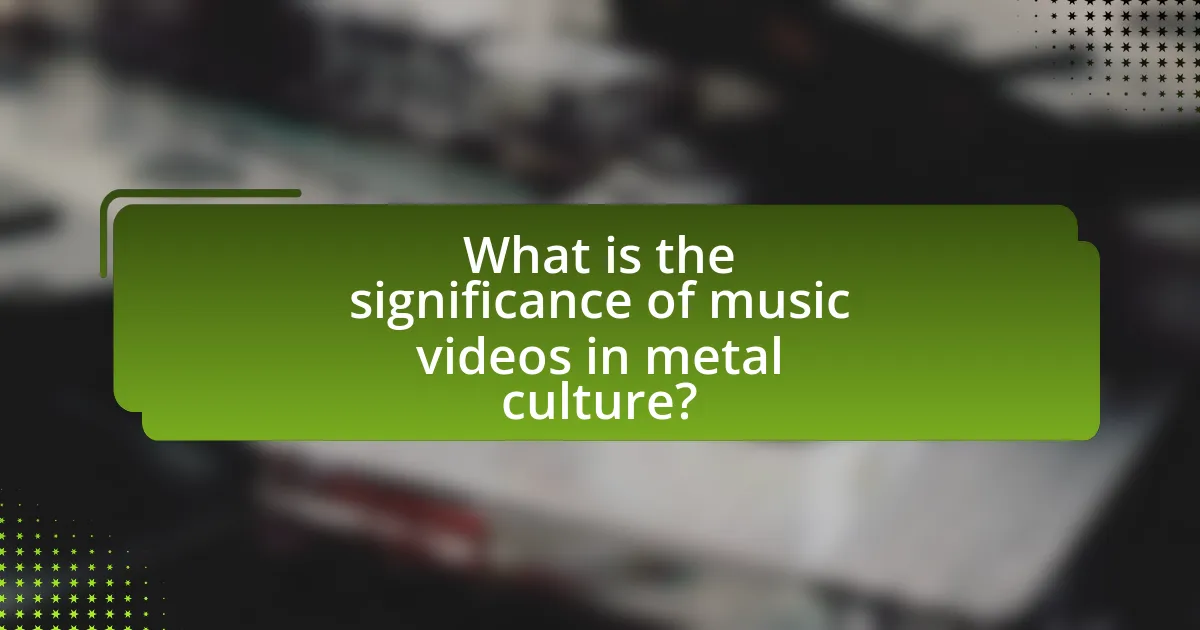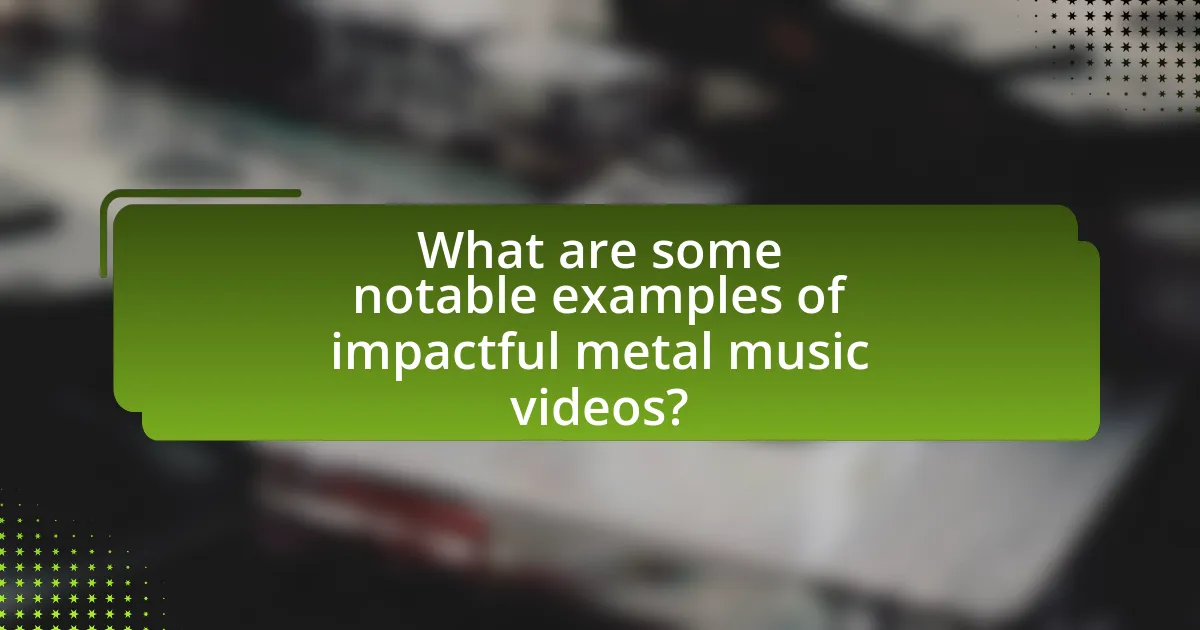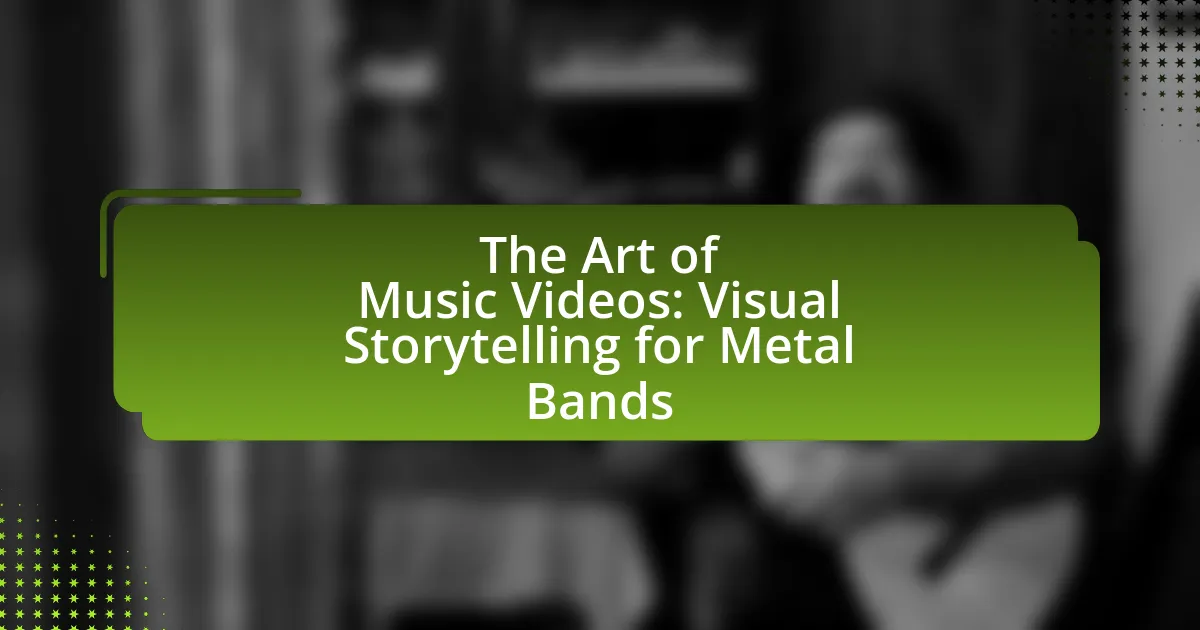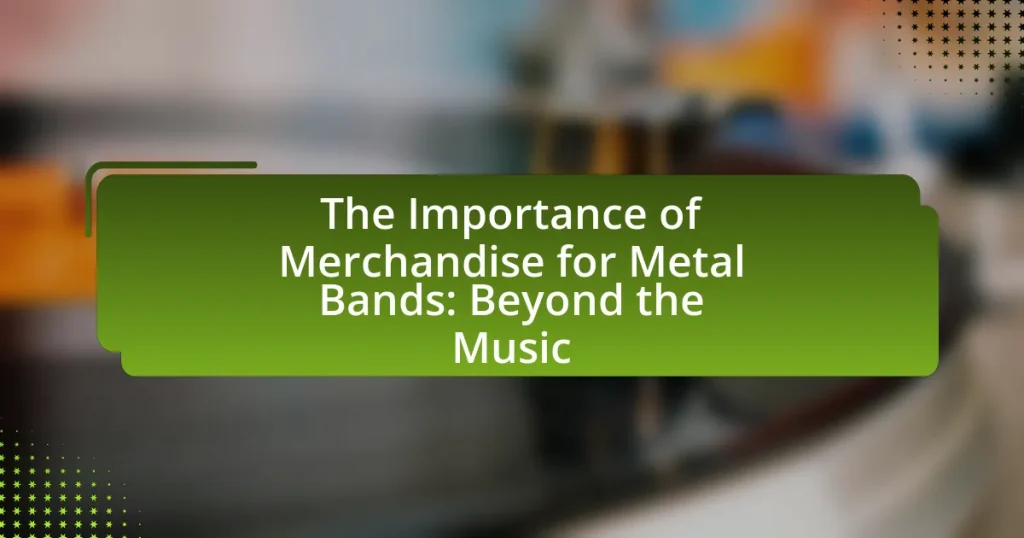The article examines the significance of music videos in metal culture, highlighting their role in visual storytelling that enhances the thematic elements of the music. It discusses how music videos amplify the emotional experience of songs, establish a band’s identity, and engage audiences through dramatic visuals and narrative techniques. Key themes explored in metal music videos include darkness, rebellion, and social issues, with notable examples illustrating their impact on the genre. The article also outlines the production process, collaboration with directors, budget considerations, and best practices for emerging metal bands to effectively utilize music videos for promotion and audience engagement.

What is the significance of music videos in metal culture?
Music videos hold significant importance in metal culture as they serve as a powerful medium for visual storytelling that enhances the thematic elements of the music. These videos often reflect the genre’s aesthetic, which includes dark imagery, elaborate narratives, and intense performances, thereby creating a deeper connection between the audience and the music. For instance, iconic metal bands like Metallica and Iron Maiden have utilized music videos to convey complex themes and showcase their artistic vision, contributing to their cultural impact. The visual representation in these videos not only amplifies the emotional experience of the songs but also helps in establishing a band’s identity within the metal community, making them essential for promotion and fan engagement.
How do music videos enhance the storytelling aspect of metal music?
Music videos enhance the storytelling aspect of metal music by visually representing the themes, emotions, and narratives conveyed in the lyrics. This visual medium allows for a deeper connection between the audience and the music, as it illustrates complex concepts such as conflict, fantasy, and personal struggles, which are prevalent in metal. For instance, the music video for “The Trooper” by Iron Maiden depicts a battle scene that aligns with the song’s lyrics about war, thereby enriching the listener’s experience and understanding of the song’s message. Additionally, studies have shown that visual elements can significantly increase audience engagement and retention, making the storytelling more impactful.
What themes are commonly explored in metal music videos?
Common themes explored in metal music videos include darkness, rebellion, fantasy, and social issues. These themes often reflect the genre’s roots in expressing emotions and challenging societal norms. For instance, many metal videos depict narratives involving horror elements, showcasing violence or supernatural beings, which aligns with the genre’s aesthetic. Additionally, themes of rebellion against authority and societal constraints are prevalent, as seen in videos that portray anti-establishment messages. Fantasy elements, such as mythical creatures and epic battles, are also frequently used to create immersive visual experiences. Furthermore, social issues like war, mental health, and inequality are addressed, providing commentary on real-world problems. This thematic diversity contributes to the rich storytelling found in metal music videos.
How do visuals complement the lyrical content in metal songs?
Visuals complement the lyrical content in metal songs by enhancing the emotional and thematic depth of the music. The imagery often reflects the dark, intense, and complex narratives found in metal lyrics, creating a more immersive experience for the audience. For instance, music videos frequently utilize dramatic visuals, such as gothic landscapes or surreal imagery, to visually interpret themes of struggle, rebellion, or existentialism present in the lyrics. This synergy between visuals and lyrics not only reinforces the message but also engages viewers on a sensory level, making the overall impact of the song more profound. Studies have shown that visual elements can significantly influence audience perception and emotional response, thereby solidifying the connection between the music and its lyrical themes.
Why are music videos essential for metal bands’ branding?
Music videos are essential for metal bands’ branding because they visually convey the band’s identity, themes, and musical style, enhancing audience engagement. The visual elements in music videos allow metal bands to create a distinct image that resonates with fans, often incorporating dramatic storytelling, symbolism, and aesthetics that reflect the genre’s intensity. For instance, bands like Metallica and Slipknot have utilized music videos to establish their unique personas and connect emotionally with their audience, leading to increased recognition and loyalty. This visual storytelling not only amplifies the band’s message but also serves as a marketing tool, as videos are widely shared across platforms, reaching broader audiences and driving album sales.
How do music videos contribute to a band’s image and identity?
Music videos significantly shape a band’s image and identity by visually representing their music, themes, and overall aesthetic. They serve as a powerful medium for storytelling, allowing bands to convey their artistic vision and connect emotionally with their audience. For instance, the imagery, style, and narrative within a music video can reinforce a band’s genre, such as the dark and aggressive visuals often associated with metal bands, which help to establish a distinct identity in a crowded market. Additionally, studies show that music videos can enhance audience engagement; for example, a 2019 survey indicated that 70% of viewers felt more connected to an artist after watching their music video. This connection can lead to increased fan loyalty and a stronger brand presence in the music industry.
What role do music videos play in audience engagement for metal bands?
Music videos play a crucial role in audience engagement for metal bands by providing a visual representation of their music that enhances emotional connection and storytelling. These videos often incorporate dramatic imagery, thematic elements, and performance footage that resonate with the band’s identity and the genre’s intensity. For instance, a study by the University of Southern California found that visual content significantly increases viewer retention and emotional response, which is particularly effective in the metal genre where themes often explore complex narratives and emotions. By utilizing striking visuals and creative storytelling, metal bands can captivate their audience, foster a deeper connection, and encourage sharing and discussion, ultimately expanding their reach and fanbase.

How do metal bands approach the creation of music videos?
Metal bands typically approach the creation of music videos by emphasizing thematic elements that resonate with their music’s intensity and lyrical content. They often incorporate dramatic visuals, narrative storytelling, and striking imagery to reflect the emotions and messages conveyed in their songs. For instance, many metal bands utilize dark, gothic aesthetics or fantasy themes to create a compelling visual representation of their music, aligning with the genre’s overall tone. This approach is supported by the fact that music videos serve as a crucial marketing tool, enhancing audience engagement and expanding their reach through platforms like YouTube, where metal music videos often garner millions of views.
What are the key steps in the music video production process for metal bands?
The key steps in the music video production process for metal bands include pre-production, production, and post-production. In the pre-production phase, the band collaborates with a director to develop a concept, create a storyboard, and plan the logistics, including location scouting and casting. During production, the band performs while the crew captures footage, ensuring that the visual style aligns with the band’s image and music. Finally, in post-production, the footage is edited, color-graded, and combined with effects and sound to create the final product. Each step is crucial for delivering a compelling visual narrative that resonates with the band’s audience.
How do bands collaborate with directors and producers for their videos?
Bands collaborate with directors and producers for their videos by engaging in pre-production discussions to align their artistic vision with the technical expertise of the filmmakers. This collaboration typically involves brainstorming concepts, sharing inspirations, and establishing a narrative that reflects the band’s music and identity. For instance, bands often provide input on themes, visual styles, and specific imagery they want to incorporate, while directors and producers contribute their creative insights and logistical planning to bring those ideas to life. This synergy is crucial, as successful music videos often result from a well-coordinated effort that combines the band’s artistic goals with the director’s storytelling capabilities and the producer’s organizational skills.
What budget considerations are involved in producing a music video?
Producing a music video involves several budget considerations, including costs for pre-production, production, and post-production. Pre-production expenses encompass scriptwriting, location scouting, casting, and scheduling, which can significantly impact the overall budget. Production costs include equipment rental, crew salaries, set design, and on-site expenses such as permits and insurance. Post-production expenses involve editing, color correction, visual effects, and sound design. According to a 2020 report by the Music Video Production Association, the average budget for a music video ranges from $10,000 to $500,000, depending on the complexity and scale of the project. These figures illustrate the financial planning necessary to ensure a successful music video production.
What creative techniques are commonly used in metal music videos?
Creative techniques commonly used in metal music videos include dramatic visual effects, narrative storytelling, and symbolic imagery. These elements enhance the intense themes often present in metal music, such as darkness, rebellion, and fantasy. For instance, the use of high-contrast lighting and rapid editing creates a sense of urgency and chaos, which aligns with the aggressive sound of the genre. Additionally, many metal videos incorporate elaborate costumes and set designs that reflect the band’s aesthetic and lyrical content, further immersing the viewer in the visual experience. This approach not only captivates the audience but also reinforces the emotional impact of the music, making the videos memorable and engaging.
How do lighting and cinematography influence the mood of a metal video?
Lighting and cinematography significantly influence the mood of a metal video by creating an atmosphere that aligns with the genre’s themes of intensity and emotion. For instance, low-key lighting often generates a dark, ominous feel, which is characteristic of many metal subgenres, while high-contrast visuals can enhance feelings of aggression and chaos. Additionally, dynamic camera movements and angles, such as quick cuts and close-ups, contribute to a sense of urgency and excitement, reinforcing the music’s energy. Studies in film theory indicate that visual elements like color grading and shot composition can evoke specific emotional responses, making them essential tools in shaping the viewer’s experience in metal videos.
What editing styles are popular in the production of metal music videos?
Popular editing styles in the production of metal music videos include fast cuts, jump cuts, and visual effects that enhance the intensity of the music. Fast cuts create a sense of urgency and energy, aligning with the aggressive nature of metal music, while jump cuts can emphasize specific moments or transitions, adding to the overall impact. Additionally, the use of visual effects such as glitch effects, color grading, and overlays often complements the thematic elements of the genre, creating a more immersive experience. These techniques are widely recognized in the industry, as evidenced by the success of iconic metal music videos that utilize these styles to engage viewers and convey the band’s artistic vision.

What are some notable examples of impactful metal music videos?
Notable examples of impactful metal music videos include “One” by Metallica, “Chop Suey!” by System of a Down, and “Duality” by Slipknot. “One” features powerful imagery depicting the horrors of war, aligning with the song’s anti-war message, and has received critical acclaim for its storytelling. “Chop Suey!” utilizes surreal visuals that reflect themes of existentialism and chaos, contributing to its status as a defining song of the early 2000s. “Duality” showcases intense visuals that capture the band’s raw energy and emotional depth, further solidifying Slipknot’s influence in the metal genre. Each of these videos has left a significant mark on the metal music landscape, demonstrating the effectiveness of visual storytelling in conveying complex themes.
Which music videos have defined the visual style of metal music?
The music videos that have defined the visual style of metal music include “One” by Metallica, “Holy Wars… The Punishment Due” by Megadeth, and “Chop Suey!” by System of a Down. “One” features a narrative that combines war imagery with haunting visuals, establishing a dark and intense aesthetic that resonates with metal themes. “Holy Wars… The Punishment Due” incorporates political and religious imagery, reflecting the genre’s often confrontational stance. “Chop Suey!” is notable for its surreal visuals and rapid editing, which capture the chaotic energy of the music. These videos have significantly influenced the visual representation of metal, showcasing themes of conflict, darkness, and emotional intensity.
What elements made these videos stand out in the metal genre?
The elements that made these videos stand out in the metal genre include striking visuals, thematic storytelling, and high-energy performances. Striking visuals often feature dark, dramatic imagery that aligns with the genre’s themes of rebellion and intensity, enhancing the overall impact. Thematic storytelling is prevalent, as many metal videos incorporate narratives that reflect the lyrics, creating a deeper connection with the audience. High-energy performances are also crucial, showcasing the musicians’ technical skills and stage presence, which resonate with the genre’s passionate fanbase. These elements collectively contribute to a memorable viewing experience that is characteristic of successful metal music videos.
How have these videos influenced other artists and genres?
Music videos in the metal genre have significantly influenced other artists and genres by integrating elaborate visual storytelling techniques that enhance the overall narrative of the music. For instance, the use of cinematic elements and thematic visuals in metal videos has inspired pop, hip-hop, and rock artists to adopt similar storytelling approaches, leading to a broader acceptance of narrative-driven content across various music styles. A notable example is the impact of Metallica’s “One,” which combined powerful imagery with a poignant narrative, prompting artists like Billie Eilish and Halsey to explore deeper emotional themes in their own music videos. This cross-genre influence demonstrates how metal’s visual storytelling has reshaped the artistic landscape, encouraging a more immersive experience for audiences.
What lessons can emerging metal bands learn from successful music videos?
Emerging metal bands can learn the importance of strong visual storytelling from successful music videos. Effective music videos often convey a narrative that resonates with the song’s themes, enhancing audience engagement. For instance, Metallica’s “One” uses powerful imagery to depict the song’s anti-war message, creating an emotional connection with viewers. Additionally, successful music videos frequently incorporate high production values, which can elevate the band’s image and attract a wider audience. A study by the University of Southern California found that visually appealing content increases viewer retention by 80%, underscoring the significance of quality visuals in music videos. By focusing on narrative, production quality, and audience connection, emerging metal bands can create impactful music videos that resonate with fans and enhance their overall brand.
What best practices should new bands consider when creating their music videos?
New bands should prioritize storytelling, visual aesthetics, and audience engagement when creating their music videos. Effective storytelling enhances the emotional connection with viewers, making the narrative relatable and memorable. Visual aesthetics, including lighting, color schemes, and cinematography, should align with the band’s image and genre, as studies show that visually appealing content increases viewer retention by up to 80%. Additionally, engaging the audience through interactive elements or behind-the-scenes content can foster a sense of community and loyalty, which is crucial for emerging artists.
How can emerging bands effectively utilize music videos for promotion?
Emerging bands can effectively utilize music videos for promotion by creating visually engaging content that resonates with their target audience. This approach not only showcases their musical talent but also builds a strong visual identity that can enhance brand recognition. For instance, a study by the University of Southern California found that music videos significantly increase audience engagement, with 70% of viewers recalling the video after watching it. Additionally, leveraging platforms like YouTube and social media for distribution can amplify reach, as these platforms have billions of active users, providing a vast audience for emerging bands. By incorporating storytelling elements that reflect their music’s themes, bands can create a deeper emotional connection with viewers, further solidifying their presence in the competitive music landscape.



